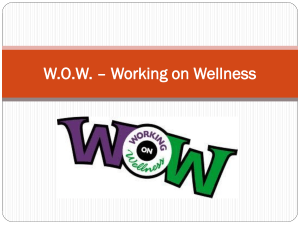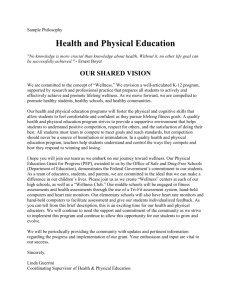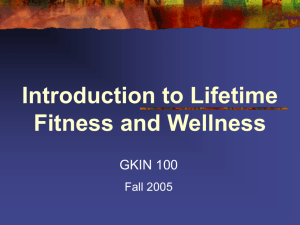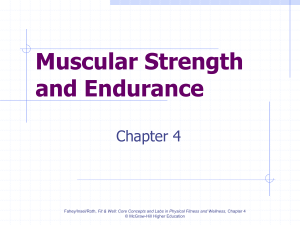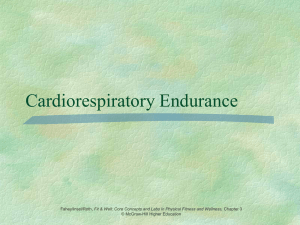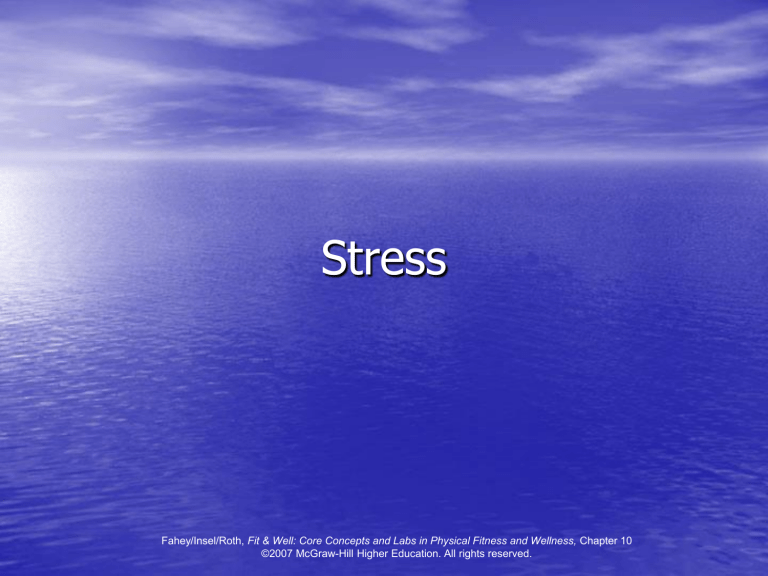
Stress
Fahey/Insel/Roth, Fit & Well: Core Concepts and Labs in Physical Fitness and Wellness, Chapter 10
©2007 McGraw-Hill Higher Education. All rights reserved.
What Is Stress?
• Stressor = any physical or psychological
event or condition that produces stress
• Stress response = the physiological
changes associated with stress
• Stress = the collective physiological and
emotional responses to any stimulus that
disturbs an individual’s homeostasis
Fahey/Insel/Roth, Fit & Well: Core Concepts and Labs in Physical Fitness and Wellness, Chapter 10
©2007 McGraw-Hill Higher Education. All rights reserved.
Physical Response to Stressors =
Fight-or-Flight Reaction
• Nervous system
– Autonomic nervous system = branch of the peripheral
nervous system that controls basic body processes
– Sympathetic division = division of the autonomic
nervous system that reacts to danger or other
challenges by accelerating body processes
– Parasympathetic division = division of the autonomic
nervous system that moderates the excitatory effect
of the sympathetic division
Fahey/Insel/Roth, Fit & Well: Core Concepts and Labs in Physical Fitness and Wellness, Chapter 10
©2007 McGraw-Hill Higher Education. All rights reserved.
Physical Response to Stressors =
Fight-or-Flight Reaction
• Endocrine system = system of glands, tissues, and cells that
•
secrete hormones into the bloodstream; influences metabolism
and body processes
Key chemical messengers during the stress response
– Norepinephrine = neurotransmitter released by the sympathetic
division to increase body functions; increases attention,
awareness, alertness
– Epinephrine = hormone secreted by the inner core of the
adrenal gland
– Cortisol = steroid hormone secreted by the outer layer of the
adrenal gland
– Endorphin = brain secretions that have pain-inhibiting effects
Fahey/Insel/Roth, Fit & Well: Core Concepts and Labs in Physical Fitness and Wellness, Chapter 10
©2007 McGraw-Hill Higher Education. All rights reserved.
Physical Response to Stressors:
Fight-or-Flight Reaction
• Together, the nervous system and the endocrine
system prepare the body to respond to a stressor
• The physiological response is the same regardless of
the nature of the stressor
• Once a stressful situation ends, the parasympathetic
division returns the body to homeostasis—a state of
stability and consistency in an individual’s
physiological functioning
• The fight-or-flight reaction is often inappropriate for
dealing with the stressors of modern life, many of
which do not require a physical response
Fahey/Insel/Roth, Fit & Well: Core Concepts and Labs in Physical Fitness and Wellness, Chapter 10
©2007 McGraw-Hill Higher Education. All rights reserved.
Fight-or-Flight
Reaction
Fahey/Insel/Roth, Fit & Well: Core Concepts and Labs in Physical Fitness and Wellness, Chapter 10
©2007 McGraw-Hill Higher Education. All rights reserved.
Fight-or-Flight
Reaction
Fahey/Insel/Roth, Fit & Well: Core Concepts and Labs in Physical Fitness and Wellness, Chapter 10
©2007 McGraw-Hill Higher Education. All rights reserved.
Actions of the
Sympathetic and
Parasympathetic
Divisions
Fahey/Insel/Roth, Fit & Well: Core Concepts and Labs in Physical Fitness and Wellness, Chapter 10
© McGraw-Hill Higher Education
Emotional and Behavioral
Responses to Stressors
• Emotional responses may include anxiety,
depression, and fear
• Behavioral responses are controlled by the
somatic nervous system = branch of the
peripheral nervous systems that governs
motor functions and sensory information;
largely under conscious control
Fahey/Insel/Roth, Fit & Well: Core Concepts and Labs in Physical Fitness and Wellness, Chapter 10
©2007 McGraw-Hill Higher Education. All rights reserved.
Stress Level, Performance, and
Well-Being
Fahey/Insel/Roth, Fit & Well: Core Concepts and Labs in Physical Fitness and Wellness, Chapter 10
©2007 McGraw-Hill Higher Education. All rights reserved.
Personality and Stress
• Type A = ultracompetitive, controlling, impatient,
aggressive, hostile
– Easily upset; react explosively to stressors
• Type B = relaxed, contemplative, tolerant of others
– React more calmly to stressors
• Type C = difficulty expressing emotions, anger
suppression, feelings of hopelessness and despair
– Exaggerated stress response
• Hardy = committed to activities, sense of inner
purpose, inner locus of control
– View stressors as challenges and opportunities for growth
Fahey/Insel/Roth, Fit & Well: Core Concepts and Labs in Physical Fitness and Wellness, Chapter 10
©2007 McGraw-Hill Higher Education. All rights reserved.
Gender and Stress
• Gender roles affect perception of and
•
•
responses to stressors
Both sexes experience the fight-or-flight
physiological response to stress
Women are more likely to respond
behaviorally with a pattern of “tend-andbefriend”
– Gender differences may be partly tied to higher
levels of the hormone oxytocin in women
Fahey/Insel/Roth, Fit & Well: Core Concepts and Labs in Physical Fitness and Wellness, Chapter 10
©2007 McGraw-Hill Higher Education. All rights reserved.
Past Experiences
• Past experiences influence the cognitive
evaluation of a potential stressor
• Effective behavioral responses can
overcome the effects of negative past
experiences
Fahey/Insel/Roth, Fit & Well: Core Concepts and Labs in Physical Fitness and Wellness, Chapter 10
©2007 McGraw-Hill Higher Education. All rights reserved.
The Stress Experience as a Whole
• Physical, emotional, and behavioral responses are
interrelated
• Symptoms of excess stress
– Physical symptoms: dry mouth, excessive perspiration,
frequent illnesses, gastrointestinal problems, grinding of teeth,
headaches, high blood pressure, pounding heart, stiff neck,
aching lower back
– Emotional symptoms: anxiety or edginess, depression,
fatigue, hypervigilance, impulsiveness, inability to concentrate,
irritability, trouble remembering things
– Behavioral symptoms: crying, disrupted eating or sleeping
habits, harsh treatment of others, problems communicating,
sexual problems, social isolation, increased used of tobacco,
alcohol or other drugs
Fahey/Insel/Roth, Fit & Well: Core Concepts and Labs in Physical Fitness and Wellness, Chapter 10
©2007 McGraw-Hill Higher Education. All rights reserved.
Stress and Wellness
• The general adaptation syndrome (GAS)
–Eustress = stress triggered by a pleasant stressor
–Distress = stress triggered by an unpleasant
stressor
• Stages of GAS
–Alarm = fight-or-flight reaction
–Resistance = new level of homeostasis
characterized by increased resistance to stress
–Exhaustion = life-threatening physiological
exhaustion
Fahey/Insel/Roth, Fit & Well: Core Concepts and Labs in Physical Fitness and Wellness, Chapter 10
©2007 McGraw-Hill Higher Education. All rights reserved.
General Adaptation Syndrome
Fahey/Insel/Roth, Fit & Well: Core Concepts and Labs in Physical Fitness and Wellness, Chapter 10
©2007 McGraw-Hill Higher Education. All rights reserved.
Stress and Wellness
• Allostatic load = long-term wear and tear of
the stress response, especially long-term
exposure to stress hormones like cortisol
– High allostatic load increases susceptibility to
disease
• Psychoneuroimmunology (PNI) = the study
of the interactions among the nervous
system, the endocrine system, and the
immune system
Fahey/Insel/Roth, Fit & Well: Core Concepts and Labs in Physical Fitness and Wellness, Chapter 10
©2007 McGraw-Hill Higher Education. All rights reserved.
Links Between Stress and Specific
Conditions
• Cardiovascular disease
• Altered functioning of the immune system
• Other health problems
Fahey/Insel/Roth, Fit & Well: Core Concepts and Labs in Physical Fitness and Wellness, Chapter 10
©2007 McGraw-Hill Higher Education. All rights reserved.
Common Sources of Stress
• Major life changes
• Daily hassles
• College stressors
– Academic stressors
– Interpersonal stressors
– Time-related pressures
– Financial concerns
Fahey/Insel/Roth, Fit & Well: Core Concepts and Labs in Physical Fitness and Wellness, Chapter 10
©2007 McGraw-Hill Higher Education. All rights reserved.
Common Sources of Stress
• Job-related stressors
• Interpersonal and social stressors
• Environmental stressors
• Internal stressors
Fahey/Insel/Roth, Fit & Well: Core Concepts and Labs in Physical Fitness and Wellness, Chapter 10
©2007 McGraw-Hill Higher Education. All rights reserved.
Counterproductive Coping
Strategies
• Tobacco
• Alcohol
• Other drugs
• Binge eating
Fahey/Insel/Roth, Fit & Well: Core Concepts and Labs in Physical Fitness and Wellness, Chapter 10
©2007 McGraw-Hill Higher Education. All rights reserved.
Managing Stress
• Exercise
– Reduces anxiety and increases sense of wellbeing
– Mobilizes energy resources to complete the
energy cycle
– Avoid compulsive exercise
• Nutrition
– Eat a balanced diet
– Avoid excess caffeine
Fahey/Insel/Roth, Fit & Well: Core Concepts and Labs in Physical Fitness and Wellness, Chapter 10
©2007 McGraw-Hill Higher Education. All rights reserved.
Managing Stress
Fahey/Insel/Roth, Fit & Well: Core Concepts and Labs in Physical Fitness and Wellness, Chapter 10
©2007 McGraw-Hill Higher Education. All rights reserved.
Managing Stress
• Sleep
– Lack of sleep is both a cause and an effect of excess
stress
• Social support
– Foster friendships
– Keep family ties strong
– Get involved with a group
• Communication
– Balance anger and assertiveness
Fahey/Insel/Roth, Fit & Well: Core Concepts and Labs in Physical Fitness and Wellness, Chapter 10
©2007 McGraw-Hill Higher Education. All rights reserved.
Managing Anger
Source: Rothwell, J. D. 2000. In the Company of Others: An Introduction to Communication. Mountain View, Calif.: Mayfield.
Fahey/Insel/Roth, Fit & Well: Core Concepts and Labs in Physical Fitness and Wellness, Chapter 10
©2007 McGraw-Hill Higher Education. All rights reserved.
Managing Stress
• Spiritual wellness can promote
–
–
–
–
–
Social support
Healthy habits
Positive attitude
Moments of relaxation
Awareness and clarification of personal values
• Paths to spiritual wellness include organized
•
religion, spending time in nature, helping others,
art or other creative endeavors, personal
relationships
Keeping a journal can help deal with stressful
events
Fahey/Insel/Roth, Fit & Well: Core Concepts and Labs in Physical Fitness and Wellness, Chapter 10
©2007 McGraw-Hill Higher Education. All rights reserved.
Managing Stress: Time Management
• Set priorities
• Schedule tasks for
•
•
•
•
•
peak efficiency
Set realisted goals
Budget enough time
Break up long-term
goals
Visualize achievement
of goals
Track tasks you put off
• Do least favorite tasks
•
•
•
•
•
•
•
first
Consolidate tasks
Identify transitional tasks
Delegate responsibility
Say no when necessary
Give yourself a break
Avoid personal time sinks
Just do it
Fahey/Insel/Roth, Fit & Well: Core Concepts and Labs in Physical Fitness and Wellness, Chapter 10
©2007 McGraw-Hill Higher Education. All rights reserved.
Managing Stress: Cognitive
Techniques
• Modify expectations
• Engage in realistic self-talk
• Live in the present
• “Go with the flow”
• Cultivate your sense of humor
Fahey/Insel/Roth, Fit & Well: Core Concepts and Labs in Physical Fitness and Wellness, Chapter 10
©2007 McGraw-Hill Higher Education. All rights reserved.
Managing Stress
• Relaxation response = a physiological
state characterized by a feeling of warmth
and quiet mental alertness
• Relaxation techniques:
– Progressive relaxation = alternating muscle
tension and relaxation
– Visualization = creating or recreating vivid
mental pictures of a place or an experience
Fahey/Insel/Roth, Fit & Well: Core Concepts and Labs in Physical Fitness and Wellness, Chapter 10
©2007 McGraw-Hill Higher Education. All rights reserved.
Managing Stress
• Relaxation techniques
– Deep, slow breathing
– Listening to music
– Meditation = quieting the mind by focusing on
a particular word, object, or process
– Hatha yoga = a series of physical postures
emphasizing balance and breathing control
– Taijiquan = a martial art designed to balance
the body’s chi to promote health and spiritual
growth
Fahey/Insel/Roth, Fit & Well: Core Concepts and Labs in Physical Fitness and Wellness, Chapter 10
©2007 McGraw-Hill Higher Education. All rights reserved.
Managing Stress
Fahey/Insel/Roth, Fit & Well: Core Concepts and Labs in Physical Fitness and Wellness, Chapter 10
©2007 McGraw-Hill Higher Education. All rights reserved.
Managing Stress
• Relaxation techniques
– Biofeedback = a technique that uses
monitoring devices to help a person become
conscious of unconscious body processes,
such as body temperature or blood pressure,
in order to exert some control over them
– Hypnosis = a technique of mental focusing
that affects the body
– Massage = manipulation of the body’s tissues
Fahey/Insel/Roth, Fit & Well: Core Concepts and Labs in Physical Fitness and Wellness, Chapter 10
©2007 McGraw-Hill Higher Education. All rights reserved.
Getting Help
• Peer counseling and support groups
• Professional help
• Is it stress or something more serious?
– Depression = a mood disorder characterized
by loss of interest in usual activities, sadness,
hopelessness, loss appetite, disturbed sleep,
and other physical symptoms
– Severe depression is linked to suicide
Fahey/Insel/Roth, Fit & Well: Core Concepts and Labs in Physical Fitness and Wellness, Chapter 10
©2007 McGraw-Hill Higher Education. All rights reserved.
Sample
Stress
Management
Contract
Fahey/Insel/Roth, Fit & Well: Core Concepts and Labs in Physical Fitness and Wellness, Chapter 10
© McGraw-Hill Higher Education
Stress
Chapter 10
Fahey/Insel/Roth, Fit & Well: Core Concepts and Labs in Physical Fitness and Wellness, Chapter 10
©2007 McGraw-Hill Higher Education. All rights reserved.



